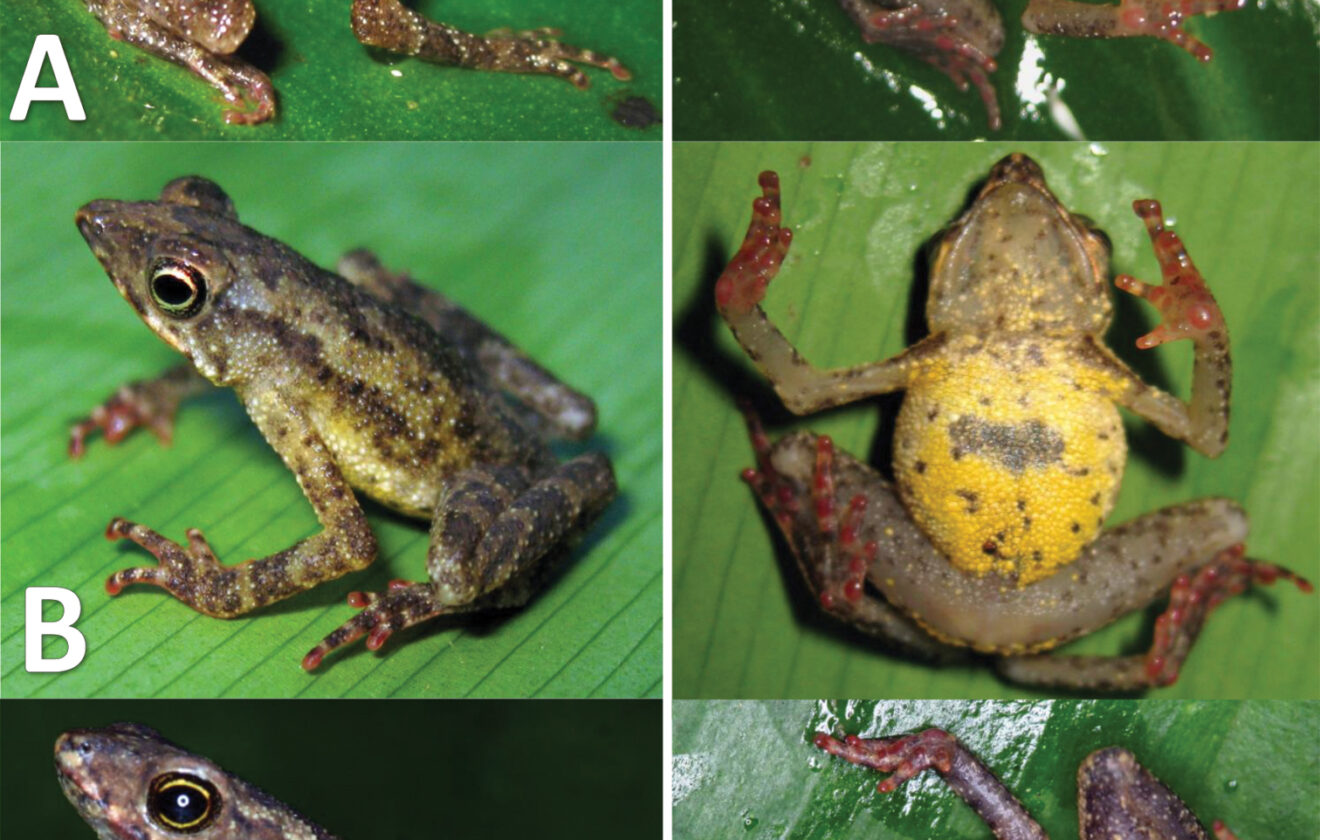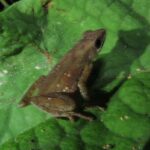- Introduction: A Tiny Ambassador of the Amazon's Secrets
- Taxonomy and Scientific Classification
- Natural Habitat: Life on the Forest Floor
- Physical Characteristics: Masters of Camouflage and Miniaturization
- Behavior and Life Cycle: Secrets of the Rainforest Litter
- Ecological Significance: A Vital Link in the Amazonian Web
- Threats and Conservation Status: Safeguarding a Hidden Gem
- Cultural and Scientific Significance: Honoring Conservation through Biodiversity
- Conclusion: The Importance of Coexistence and Conservation
Introduction: A Tiny Ambassador of the Amazon’s Secrets#
Nestled in the lush and shaded corners of the Amazonian rainforest floor hides a miniature guardian of biodiversity, the tiny yet remarkable amphibian known as Amazophrynella javierbustamantei. At first glance, this diminutive toad might appear inconsequential, blending effortlessly into the leaf litter and dappled shadows of its home. Yet, beneath its subtle appearance lies one of the Amazon rainforest’s most fascinating ecological stories and scientific revelations.
First scientifically described as recently as 2016, Amazophrynella javierbustamantei belongs to a family of toads long admired and studied for their mysterious behaviors, incredible habitat adaptations, and notable chemical defenses. Named in honor of conservationist Javier Bustamante, this distinctive amphibian not only highlights the rich biodiversity found in the region but also sheds valuable light on how small species profoundly influence tropical ecosystems.
Taxonomy and Scientific Classification#
A member of the Bufonidae family, which broadly includes true toads, the Amazophrynella genus stands out for its distinctive habitat preferences and smaller size compared to many of its Bufonidae cousins. Within its family tree, Amazophrynella javierbustamantei shares a close lineage with similarly secretive and diminutive species characterized by their intricate patterns, coloration variations, and rainforest-litter camouflage.
The classification is as follows:
- Kingdom: Animalia
- Phylum: Chordata
- Class: Amphibia
- Order: Anura
- Family: Bufonidae
- Genus: Amazophrynella
- Species: Amazophrynella javierbustamantei
Natural Habitat: Life on the Forest Floor#
Geographic Range and Distribution#
Amazophrynella javierbustamantei primarily inhabits the humid lowland rainforests of southern Peru, particularly in regions surrounding Madre de Dios and Tambopata. These regions boast incredible biodiversity and provide ideal conditions for such a minute amphibian. Its range likely extends subtly into neighboring border zones, though documented populations remain fairly localized and fragmented.
Preferred Microhabitat Conditions#
Unlike larger amphibians which often soak in visible ponds or streams, Amazophrynella javierbustamantei prefers the safety and secrecy of moisture-rich leaf litter. Within these earthy layers, moisture levels remain consistently humid, which is critical for amphibian skin respiration and hydration. Pockets of shaded rainforest floor near temporary water bodies or slow-flowing streams provide these tiny toads with an optimal balance of protective camouflage, moisture conservation, and abundant prey resources.
Physical Characteristics: Masters of Camouflage and Miniaturization#
The first thing to note about Amazophrynella javierbustamantei is its modest size—a mere 17 to 20 millimeters in adult length, rendering it among the smaller terrestrial amphibians of the Amazon basin. Its small stature belies remarkable complexity: subtle variations in skin texture and coloration patterns give it extraordinary powers of camouflage.
The dorsal side showcases earthy tones, from rust-colored browns to deep olive greens, perfectly mimicking the decomposing foliage and ground debris of its forest floor home. Mottled patterns offer juvenile and adult frogs alike natural concealment against predators. Its belly tends to be lighter, typically a beige or cream shade, allowing it to blend effectively when stationary amid foliage shadows and blending seamlessly into its surroundings.
Anatomical Adaptations for Survival#
This tiny toad species possesses remarkably delicate limbs finely tuned for swift, yet stealthy movements. Its digits feature small but efficient pads which tremendously aid navigation on leaf litter, while its short legs provide sprightly hopping capabilities, essential for evading predators.
Behavior and Life Cycle: Secrets of the Rainforest Litter#
Feeding Habits and Predation Tactics#
Feeding primarily on ants, small beetles, mites, and springtails, Amazophrynella javierbustamantei exhibits a delicately adapted hunting strategy perfectly attuned to its microhabitat. It relies predominantly on ambush predation, silently waiting beneath leaves or debris and striking swiftly when prey moves within reach.
Breeding Rituals and Developmental Stages#
During periods of heavy rainfall, breeding season commences. Males begin a chorus of subtle yet rhythmic calls—delicate chirps and clicks used to attract females. Hidden within dense vegetation near temporary forest pools, males stake their claims on prime territory. Successful courtship culminates in females depositing small clusters of eggs in transient pools or damp leaf litter depressions, where conditions favor rapid embryonic development.
Unusually for amphibians, Amazophrynella tadpoles are quite hardy; many stages of their development happen rapidly, minimizing exposure to predation risk in fragile puddles that briefly flourish after rainstorms. Within a short few weeks, small froglets emerge, carrying on this species’ unseen, yet vital, rainforest existence.
Ecological Significance: A Vital Link in the Amazonian Web#
Amazophrynella javierbustamantei holds an intricate role as an essential predator of small arthropods, thus contributing to insect population control. In turn, this tiny amphibian itself serves as food for larger predators—from snakes to birds—thereby maintaining balance within the rainforest food web. Its presence, abundance, and health are indispensable indicators of environmental quality, providing researchers critical insights into ecosystem disturbances such as deforestation, pollution, or climate change.
Threats and Conservation Status: Safeguarding a Hidden Gem#
Given its limited known distribution, Amazophrynella javierbustamantei is inherently vulnerable. Habitat loss due to rampant deforestation, mining operations—especially from gold extraction practices—and climate shifts potentially pose serious threats. Fragmentation of habitats isolates populations, diminishes genetic diversity, and heightens susceptibility to disease outbreaks, particularly the fungal disease chytridiomycosis, which has devastated many amphibian populations around the world.
Though presently lacking an official IUCN classification due to its recent description, the species’ localized habitat and clear challenges necessitate immediate monitoring and protection. Recognizing its critical role, several conservationist groups in Peru are actively advocating for habitat preservation and protective legislations, leveraging scientific studies to establish protected areas and stricter controls on local extractive industries.
Cultural and Scientific Significance: Honoring Conservation through Biodiversity#
The specific epithet, javierbustamantei, honors conservationist Javier Bustamante, whose tireless commitment to preserving Amazonian biodiversity epitomizes the synergy between scientific discovery and active environmentalism. On a broader level, small species like Amazophrynella javierbustamantei have become emblematic for showcasing the hidden complexities and inherent richness of rainforest ecosystems, drawing global attention and support toward conservation initiatives.
Conclusion: The Importance of Coexistence and Conservation#
In the perpetually shadowed, leaf-littered floors of the Amazon basin, Amazophrynella javierbustamantei quietly underscores the vital interconnectedness of life’s web. Understanding and conserving it, along with countless other unseen beings sharing its habitat, is pivotal for maintaining the health and continued diversity of these ancient forests. Each discovery, like this tiny toad, reminds us that even the smallest voice harbors powerful messages about ecological harmony, biodiversity’s treasure trove, and our collective responsibility to protect and steward the living wonders of our shared planet.
Discover more about conserving rainforests and amphibian populations by visiting conservation groups such as the Amphibian Survival Alliance and support ongoing efforts to protect this delicate and unique species.















